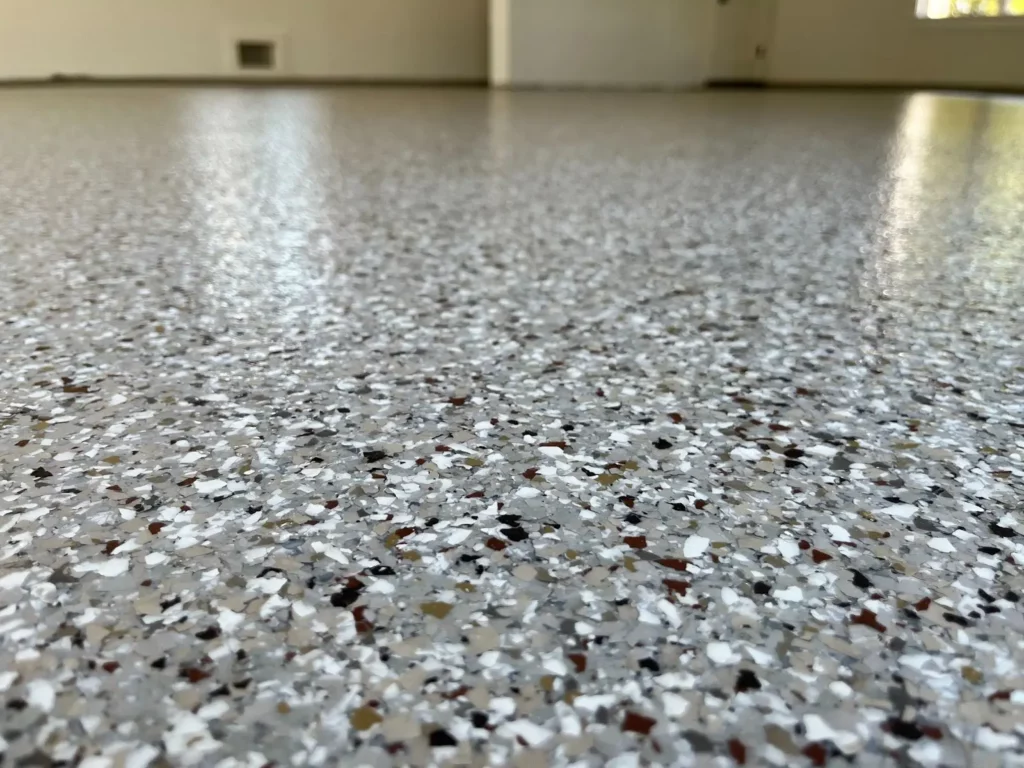Introduction
When it comes to sustainable and durable flooring, epoxy floors stand out for their resilience, low maintenance, and aesthetic versatility. Especially important for environmentally-conscious architects and builders, these floors offer a hard-wearing surface that’s both cost-effective and aligns with green building principles. But how do you keep them looking great with minimal effort?
Quick Clean Guide:
- Sweep daily to remove dirt and grit.
- Spot clean spills immediately using warm water.
- Avoid soap-based cleaners to prevent a hazy buildup.
- For heavy soil, use warm water and a hard foam mop, followed by an ammonia/water mix if necessary.
- Address stains and chemical spills promptly with appropriate cleaners and tools.
Epoxy floors don’t just promise durability; they deliver it, provided they’re cared for properly. Below, we’ll walk you through a simple, environmentally-friendly routine to ensure your epoxy floors maintain their luster and longevity, supporting both your design ethos and the planet.

Step 1: Daily Maintenance
Keeping your epoxy floors in top shape starts with some simple, everyday actions. By incorporating these habits into your routine, you can maintain the beauty and durability of your flooring with minimal effort.
Sweep Regularly
The first step in maintaining your epoxy floor is to sweep it daily. This removes the loose dirt, dust, and debris that can accumulate on the surface. A soft-bristled broom or a microfiber mop works best for this task, as they are gentle on the epoxy coating while effective at capturing dirt.
Vacuum as Needed
For areas that get more traffic or for those days when dirt and grit seem to be everywhere, use a vacuum with a soft brush attachment. This is especially important in commercial settings or garages where the floor might see more wear and tear from machinery and vehicles. The soft brush attachment ensures that while you’re removing the dirt, you’re not scratching the epoxy coating.
Dealing with Dirt and Grit
Dirt and grit can act like sandpaper on your epoxy floor, dulling its shine over time if not regularly removed. When sweeping or vacuuming, pay special attention to the entryways and high-traffic areas where dirt is most likely to be tracked in. Placing doormats at entrances can help reduce the amount of dirt brought onto your floors.
The Right Tools Make a Difference
Using the right tools for daily maintenance can extend the life of your epoxy floors significantly. Soft brushes and microfiber mops are gentle on the epoxy surface, preventing scratches or other damage that could occur from using harsher cleaning tools.
By following these simple daily maintenance steps, you can keep your epoxy floors looking as good as new. The key to longevity is regular care and attention to avoid the buildup of dirt and grime that can compromise the integrity and appearance of your flooring.
In the next section, we’ll look at how to tackle spills and stains, ensuring your epoxy floors remain spotless and stunning.

Step 2: Spot Cleaning
When life happens, spills follow. Whether it’s a splash of coffee or drops of motor oil, knowing how to clean epoxy floors in the event of spills is crucial to maintaining their shine and longevity. Here’s a straightforward approach to spot cleaning on your epoxy floor.
Spills:
The first rule of spills? Act fast. The quicker you address the spill, the less chance it has to stain or damage the floor.
- For Liquid Spills:
- Mop it up: Grab a clean, dry mop or a bunch of shop towels. Gently blot the spill to absorb as much liquid as possible.
-
Warm Water Rinse: If the spill was sticky or left a residue, dampen a mop with warm water and go over the area. This helps to remove any leftover substance without using harsh chemicals.
-
For Greasy or Oily Spills:
- Shop Vac: If you have a shop vac, it’s perfect for picking up these kinds of spills. It removes the liquid and some of the greasiness that can be left behind.
- Warm Water and Mild Dish Soap: For any residue, a light solution of warm water and a squirt of mild dish soap can help. Mop the area gently and then rinse with just warm water.
Warm Water:
Warm water is your best friend when it comes to spot cleaning epoxy floors. It’s gentle enough not to damage the coating but effective enough to help remove spills without leaving a mark.
Shop Vac:
For larger spills or those that have started to dry, a shop vac can be a very effective tool. It sucks up both the liquid and any particulate matter, leaving your floor clean and dry.
The key to effective spot cleaning is immediate action and the right tools. Warm water, a good mop, and a shop vac can handle most spills without the need for harsh chemicals. By following these simple steps, you can keep your epoxy floors looking new for years to come.
In our next section, we’ll delve into why it’s important to avoid harsh chemicals and what alternatives you can use for a deeper clean without compromising the floor’s integrity.
Step 3: Avoid Harsh Chemicals
When figuring out how to clean epoxy floors, it’s tempting to reach for the strongest cleaner in the cupboard. But here’s the thing: harsh chemicals are not your friend when it comes to epoxy floors. Soap-based cleaners, for example, might leave a haze on the floor that dulls its sparkle. And we don’t want that, do we?
Instead, think of cleaning your epoxy floors like you would wash a fancy car. You wouldn’t use dish soap on a Ferrari, right? The same logic applies here.
The Safe Cleaning Trio:
-
Warm Water: Often, all you need is some warm water to get the job done. It’s gentle, effective, and won’t leave any residue.
-
Deck-scrubbing Brush: For spots where dirt’s a bit more stubborn, a deck-scrubbing brush with soft bristles can work wonders. It’s tough on dirt but gentle on your floor.
-
Diluted Ammonia Solution: For a deeper clean, diluted ammonia (about half a cup to a gallon of water) can cut through grime without damaging the epoxy. Just ensure the room is well-ventilated, and you’re not using it too frequently.
What Not to Use:
-
Soap-Based Cleaners: They can leave a film that makes the floor slippery and dull.
-
Citric Acid or Vinegar: These might clean well but can damage the epoxy’s glossy finish over time.
-
Bleach: It’s too harsh and can lead to discoloration.
By sticking to these simple guidelines, your epoxy floors will not only look great but will also maintain their integrity for longer. The key to a long-lasting epoxy floor is as much about what you don’t use as what you do.
Moving forward, we’ll tackle how to handle heavily soiled floors without resorting to those harsh chemicals we just talked about avoiding. It’s all about balance and knowing the right tools and solutions to use for every situation.
Step 4: Tackling Heavily Soiled Floors
When your epoxy floor faces the rough and tough, it calls for some extra care. Here’s how to clean epoxy floors that have seen better days, focusing on getting rid of heavy soil without damaging the surface.
1. Sweep and Vacuum: Start by removing all loose debris. Use a soft broom or a vacuum cleaner with a soft brush attachment. It’s important to get all the bits and pieces off the floor to avoid scratching the epoxy coating during the wet cleaning process.
2. Choose Your Mop Wisely: A hard foam mop is your best friend here. It’s gentle on the epoxy yet effective in cleaning. Avoid using string mops as they can leave streaks and sometimes even bits of themselves behind.
3. Prepare Your Cleaning Solution: Warm or hot water works best for dissolving grime. Now, here’s where it gets specific: a diluted ammonia solution is your go-to. Mix about half a cup of ammonia with a gallon (3.8 L) of hot water. This solution is safe for epoxy floors and is effective in cutting through the grime without leaving a residue or damaging the surface.
4. Mop Away: Soak your hard foam mop in the ammonia solution and wring it well. Then, mop your floor section by section. The key here is to keep the mop damp, not wet, to avoid puddling, which can leave water spots.
5. Rinse and Repeat if Necessary: After mopping with the ammonia solution, it’s crucial to rinse the floor with clean water. This step ensures that no cleaning solution residue remains on the floor. If the floor was very dirty, you might need to repeat the mopping and rinsing process to get rid of all the dirt.
Tackling heavily soiled epoxy floors doesn’t have to be a daunting task. With the right tools and solutions, you can get your floor looking as good as new without risking damage. Always start with the gentlest cleaning methods and escalate only as needed to keep your epoxy floor in top condition.
Step 5: Addressing Stains and Chemical Spills
When it comes to keeping your epoxy floors looking their best, addressing stains and chemical spills promptly is key. Here’s how to tackle these common issues:
Rust Stains
- Kitchen Scrubbing Sponge or Soft Deck Brush: For rust stains, dampen a kitchen scrubbing sponge or a soft deck brush with warm water.
- Scrub Gently: Apply a bit of elbow grease to gently scrub the stain. Often, warm water is enough to remove or lessen the appearance of rust stains.
- Avoid Harsh Chemicals: Harsh chemicals can do more harm than good. Stick to mild, non-abrasive options.
Oil Spills
- Act Quickly: The sooner you address oil spills, the easier they will be to clean.
- Shop Towels: Use shop towels or paper towels to blot up as much of the oil as possible. Avoid rubbing, as this can push the oil deeper into the epoxy.
- Proper Disposal: Dispose of the used towels properly, considering the environmental impact.
For both types of spills, the key is to act quickly and use the right tools. A gentle approach can often resolve the issue without damaging your epoxy floors. And remember, for more detailed guidance on maintaining your epoxy floors, including how to deal with specific types of stains, you can find comprehensive advice here.
Continuing to maintain your epoxy floors with these steps will not only keep them looking their best but also extend their lifespan, offering long-term value and beauty to your space.
Frequently Asked Questions about Epoxy Floors
When it comes to how to clean epoxy floors, there are a few common questions that pop up. Let’s dive into some of these to help you better understand the care and maintenance of your epoxy floors.
Can I use vinegar to clean an epoxy floor?
No, it’s not recommended to use vinegar to clean an epoxy floor. Vinegar is acidic and can dull the shiny surface of your epoxy flooring. Instead, stick to using a mixture of warm water for regular cleaning. For more stubborn dirt, a mild detergent can be used, but always ensure it’s rinsed thoroughly to avoid leaving any residue.
How often should I recoat my epoxy floor?
The need to recoat your epoxy floor depends on the level of traffic and use it gets. For commercial spaces with heavy traffic, recoating might be necessary every few years. In residential settings, such as garages, you might find that your floor lasts much longer before needing a refresh. A good rule of thumb is to inspect your floor annually for signs of wear and tear, and decide if it’s time for a new coat.
Is it safe to pressure wash epoxy flooring?
Using a pressure washer on your epoxy floor isn’t generally recommended. While epoxy floors are durable, the high pressure from a washer can potentially damage the surface or get water underneath the coating, leading to peeling or other issues. For heavily soiled floors, stick to a hard foam mop and a mix of warm water and a gentle cleaner. If you’re dealing with very stubborn dirt, consider consulting a professional before resorting to pressure washing.
Maintaining your epoxy floors doesn’t have to be complicated. With routine care and the right cleaning methods, your floors can continue to shine and perform well for years to come. If you encounter any specific challenges or need further guidance on maintaining your epoxy floors, including how to deal with specific types of stains, you can find comprehensive advice here.
Continuing to maintain your epoxy floors with these steps will not only keep them looking their best but also extend their lifespan, offering long-term value and beauty to your space.
Conclusion
Sustainable Design & Topcoat Services
In wrapping up, understanding how to clean epoxy floors is key to maintaining their beauty and durability. These floors offer a blend of functionality and aesthetics that make them a smart choice for anyone looking for a low-maintenance, yet stylish flooring option. Sustainable design isn’t just about choosing materials that are good for the planet; it’s also about selecting options that will last longer, reduce waste, and require less frequent replacements or repairs. Epoxy floors fit perfectly into this philosophy.
At Topcoat Services, we take pride in offering flooring solutions that not only meet your aesthetic desires but also align with sustainable design principles. Our epoxy flooring options are designed to withstand the rigors of daily use without compromising on style. By following the simple steps outlined for cleaning and maintaining your epoxy floors, you’re not just taking care of your investment; you’re also contributing to a more sustainable future.
The key to keeping your epoxy floors in pristine condition is regular maintenance and avoiding harsh chemicals that can damage the surface. For more detailed information and tailored advice, our team at Topcoat Services is always here to help. We’re committed to providing you with the best solutions for your flooring needs, ensuring that they remain a valuable and beautiful part of your space for years to come.
Epoxy floors, with the right care, can be a testament to the beauty and resilience of sustainable design. Let’s embrace these practices together, making our spaces more durable, beautiful, and environmentally friendly. For all your flooring needs, trust Topcoat Services to provide the expertise and quality you deserve.









